You'll immerse yourself in the ancient traditions of the Philippine Cordilleras as you explore the breathtaking Rice Terraces, a tribute to the ingenuity of the Ifugao people's 2,000-year-old agricultural practices. As you wander through this cultural landscape, you'll discover a complex network of water resources, notable agricultural features like Muyongs and the revered lunar cycle-based pest control, and intricate social dynamics tied to small-scale farming. The terraces' reflection on the collective efforts of local communities will also feature prominently, showcasing cultural expressions through festivals like Tunggul and even more agricultural traditions remain waiting to be uncovered.
Cultural Significance of the Terraces
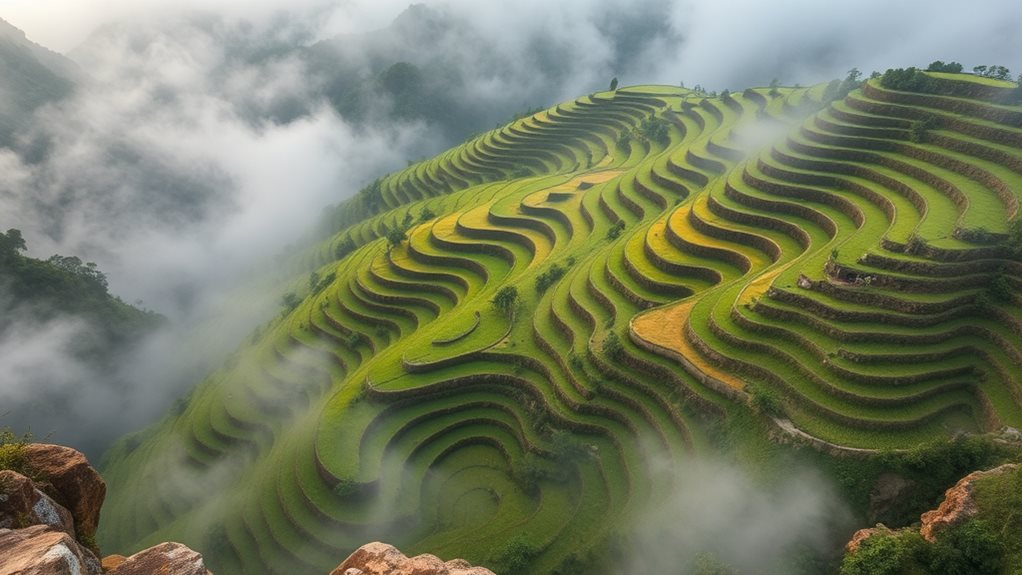
The Rice Terraces of the Philippine Cordillera are a defining feature of Ifugao culture, cultivated by the community's ancestors for over 2,000 years. As you explore the terraces, you'll witness a rich cultural heritage and sustainable agricultural practices that have been perfected over centuries.
The terraces embody the Ifugao people's deep connection with their environment, showcasing their engineering skills and traditional land-use practices. Walking through the terraces, you'll notice the intricate web of social bonds between the Ifugao people.
The communal cooperation required for planting and harvesting reflects the strong social cohesion within the community, emphasizing the importance of collaboration in their agricultural practices. Agricultural practices are intricately linked to lunar cycles and traditional religious rituals, making the terraces a living cultural landscape that embodies the harmonious relationship between the Ifugao people and their environment.
The terraces have been recognized as a National Cultural Treasure and a UNESCO World Heritage Site, symbolizing the Ifugao people's resilience and the preservation of their ancestral knowledge and traditions. They represent a crucial part of the Ifugao identity, and their significance extends far beyond their agricultural value.
As you immerse yourself in the terraces, you'll come to understand the depth of the Ifugao people's connection with their land, their culture, and their traditions. It's an experience that will leave you in awe of the enduring beauty and cultural significance of the Philippine Cordillera's terraced landscape.
Agricultural Practices and Heritage
Agriculture has played an essential role in the lives of the Ifugao people for centuries, with the terraces serving as a proof of their ingenuity and expertise. As you walk through the Ifugao Rice Terraces, you'll notice the intricate irrigation system that allows for adequate flooding of the terraces, utilizing water harvested from forest-clad mountain tops. This ingenious system shows that the Ifugao people have mastered the art of managing water resources for rice cultivation.
Muyongs, or protected watersheds, are a vital element in the sustainable agricultural practices of the Ifugao people. These watersheds preserve water resources, ensuring a consistent supply for rice cultivation. The Food and Agriculture Organization has recognized this agricultural system as an outstanding one, declaring the terraces a pilot for Globally Important Agricultural Heritage Systems (GIAHS) in 2002.
As you explore the terraces, you'll observe traditional farming practices that have been maintained over generations. Locally adapted management techniques reflect the deep agricultural knowledge of the Ifugao community.
Seasonal systems of pest control and crop management are integral to the traditional agricultural practices of the Ifugao. These methods are intricately linked to lunar cycles and religious rituals. By understanding these practices, you'll appreciate the Ifugao people's harmonious relationship with nature.
The Ifugao Rice Terraces demonstrate a remarkable example of sustainable agricultural practices, showcasing the community's ingenuity and expertise. As you learn about their methods, you'll gain insight into the importance of preserving traditional knowledge and cultural heritage.
Community and Cultural Aspects Explained
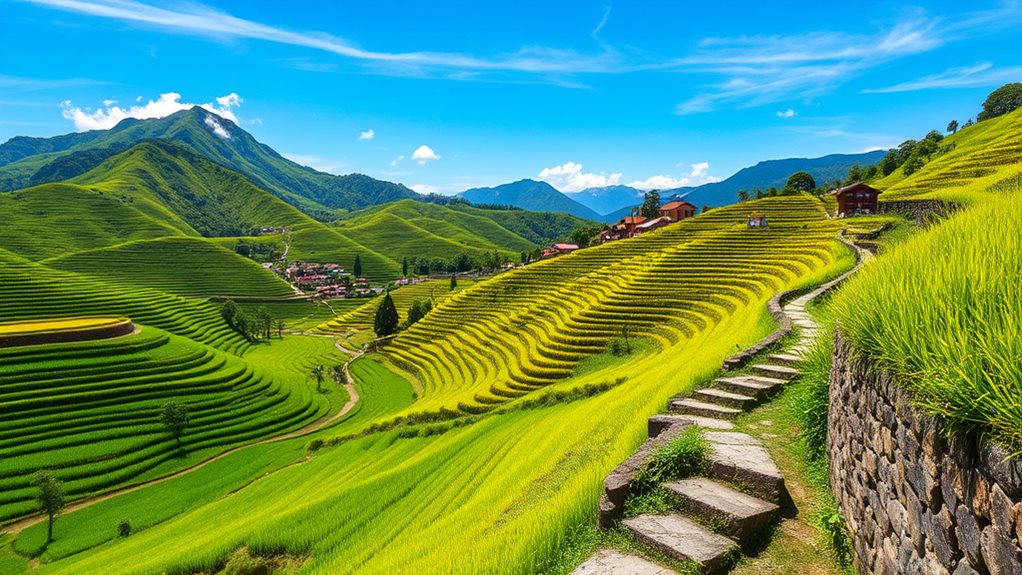
At the heart of the Ifugao culture lies a profound connection to the Rice Terraces, where community, tradition, and innovation converge in a delicate balance of interests, responsibilities, and family ties that have lasted for over 2,000 years.
You'll notice that planting and harvesting rice is a communal effort, with traditional practices synchronized with lunar cycles and religious rituals. This community cooperation reinforces cultural ties and shared responsibilities among families and villages, highlighting the importance of collective work and mutual support.
You'll see firsthand how the terraces are maintained through the collective efforts of generations of small-scale farmers. This intricate knowledge of sustainable land use and irrigation systems has been passed down through the Ifugao community, demonstrating their commitment to preserving their agricultural heritage.
Cultural conservation efforts, including promoting traditional farming methods and responsible tourism, are essential for preserving the unique heritage of the Ifugao people and ensuring their sustainable livelihoods. Festivals like Tunggul celebrate Ifugao culture, showcasing their culinary traditions and social bonds while emphasizing community engagement in maintaining their agricultural heritage.
In this way, the Ifugao people have created a thriving cultural ecosystem that blends tradition, innovation, and community cooperation. By supporting sustainable livelihoods, you're helping to preserve the cultural rituals and community bonds that define this remarkable region.
As you explore the Rice Terraces, you'll witness the deep connection between the Ifugao people and their land, a reflection of the enduring power of community, tradition, and a shared commitment to cultural heritage.
Unique Features of the Terraces
Situated in the rolling hills and rugged mountains of the Philippine Cordilleras, the rice terraces stand as one of the most impressive feats of ancient engineering, showcasing the ingenuity and perseverance of the Ifugao people.
You'll notice how these terraces seem to defy gravity, built on steep slopes with a maximum incline of 70 degrees, reaching impressive heights of up to 10 feet. The sheer scale of these engineering feats is remarkable, with structures that have stood the proof of time, such as the ancient stone walls in Hungduan, dating back to 650 AD.
Take a closer look, and you'll notice the intricate stone wall construction that prevents erosion in the Batad Rice Terraces, showcasing the Ifugao people's mastery of local materials.
At the Bangaan Rice Terraces, contrast is key, with mud walls complementing the traditional village, while nearby stone walls like those in Batad demonstrate a testament to their durability.
The unique irrigation systems employed across the terraces, including earthen dikes and bamboo pipes, are the real backbone of this sophisticated rice cultivation operation. Without these systems, the terraces wouldn't be able to thrive in the mountainous setting.
The Banaue Rice Terraces themselves are renowned for their stunning beauty, and serve as a shining example of the engineering and agricultural prowess of the Ifugao people.
Every aspect of these terraces is a symbol of the region's impressive cultural heritage. The intricate details and clever designs are truly awe-inspiring, making the rice terraces of the Philippine Cordilleras a must-see natural wonder.
Challenges in Preserving the Terraces
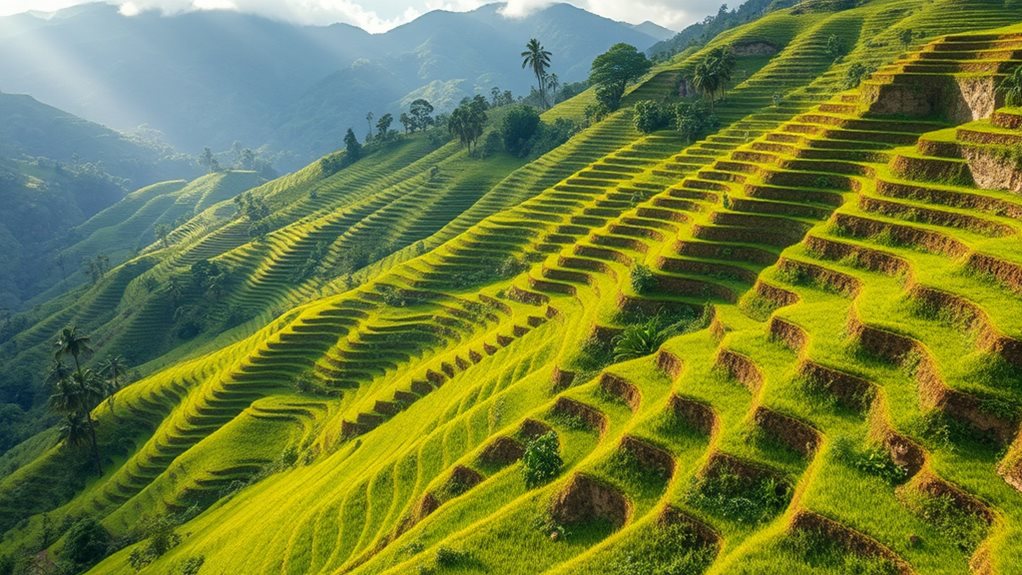
The ingenuity and perseverance that went into building the rice terraces of the Philippine Cordilleras are facing unprecedented challenges in preserving these remarkable structures for future generations.
You've witnessed the grandeur of these terraces firsthand, but now it's crucial to address the issues threatening their very existence. With about 25-30% of the terraces abandoned and deteriorating, it's clear that neglect and erosion are taking their toll. Rural-to-urban migration and climate change have led to the loss of traditional irrigation systems, critical for sustaining the terraces. Labor shortages, exacerbated by younger generations moving away from farming, have further worsened the problem.
As you explore the terraces, you'll notice the telltale signs of erosion and soil degradation. Some terraces require renovation to counteract the effects of neglect and environmental changes.
This highlights the urgent need for sustainable tourism practices, which must balance economic reliance on visitors with preserving cultural heritage and traditional farming techniques. Revitalizing interest in agricultural practices requires community engagement, guaranteeing the continuation of traditional knowledge and the integrity of the terraces.
The fate of these magnificent structures hangs in the balance, and it's up to you to recognize the challenges that must be overcome to preserve the terraces for future generations. By acknowledging these challenges, you can help spark a renewed effort to revitalize the rice terraces and safeguard their survival for centuries to come.
Conservation Efforts and Initiatives
Regular conservation efforts have been underway in the Philippine Cordilleras to protect the rice terraces, a UNESCO World Heritage Site, from the ravages of time and environmental factors.
You're likely aware that the terraces were once listed as a World Heritage Site in Danger, but thanks to concerted efforts, they were removed from this list in 2012. One key player in this success is the Ifugao Terraces Commission, which oversees the protection and management of the terraces, implementing Community-Based Land Use and Zoning Plans (CBLUZP) to safeguard their integrity and sustainability.
You'll be happy to know that government programs are also focused on improving economic conditions in the region while preserving the terraces, emphasizing the importance of sustainable practices and community involvement.
Indigenous Ifugao stakeholders play a crucial role in this process, ensuring that traditional practices and knowledge are passed down through generations to maintain the terraces' agricultural significance.
In fact, ongoing landscape restoration and revival of traditional farming practices are prioritized in conservation efforts to secure the cultural and historical value of the terraces for future generations.
This collaborative approach allows for the conservation of the terraces while also benefiting the local community. By prioritizing sustainable practices, conservation efforts are yielding positive results, and the terraces can continue to thrive for centuries to come.
Thorough conservation measures are being taken to safeguard the future of this incredible natural and cultural wonder.
Travel Information and Tips
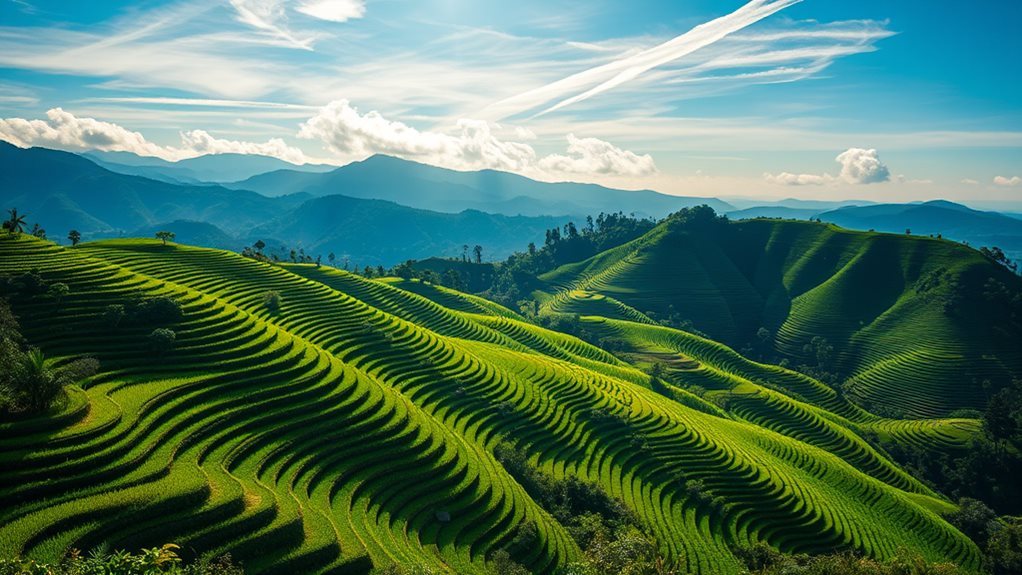
As travelers initiate the journey to explore the Philippine Cordilleras, one of the most significant challenges lies in steering through the rugged terrain that encapsulates the breathtaking Banaue Rice Terraces.
To guarantee a smooth and enjoyable trip, gathering accurate travel information is essential. The terraces are accessible via daily bus services from Manila, which take approximately 8-10 hours, covering a distance of 216 miles.
Once you arrive, prepare to hike to Batad village, a 2-hour trek that offers an incredible opportunity to experience the stunning landscapes up close. Before starting this adventure, check the weather conditions to guarantee a pleasant hike. Cooler temperatures and afternoon thunderstorms can impact travel plans, particularly during the wet season. Be sure to pack accordingly to make the most of your trip.
To immerse yourself in the local culture, book accommodations in advance, as options are limited. Homestays and guesthouses provide an authentic taste of Ifugao hospitality and are a great way to engage with the community.
However, remember to practice responsible tourism to preserve the terraces and cultural heritage of the Ifugao people. This not only benefits the local community but also enriches your travel experience. By being mindful of your impact and choosing eco-friendly accommodations, you can contribute to the long-term preservation of this natural wonder.
Best Time to Visit the Terraces
In the Philippines, the Cordillera region is a year-round destination, but the best time to visit the Banaue Rice Terraces is during the dry season, which spans from November to May. You'll enjoy more favorable weather conditions, making it ideal for outdoor activities and taking in the breathtaking views.
During this period, you'll experience cooler temperatures, especially at night, providing a comfortable climate for hiking and exploring the terraces. The dry months also minimize disruptions caused by rain and fog, which can make traveling on narrow mountain roads challenging.
You'll have plenty of time to discover the terraces' intricate design and learn about the history and culture of the indigenous people who built them.
June is a great month to visit the terraces if you're interested in witnessing traditional rice farming practices up close. This is peak harvest time, and you'll see vibrant landscapes and local activity in full swing.
If you're a photography enthusiast, the winter months offer the clearest visibility for stunning captures of the terraced landscapes.
Don't miss the opportunity to visit the Banaue Rice Terraces between November and May, when the dry season offers the best conditions for an unforgettable experience.
Take advantage of the comfortable climate and clear visibility to capture the essence of this incredible destination. Your trip will be all the more worthwhile when you get to witness the ancient rice farming methods in action, and take home stunning photographs of the terraced landscapes.
Tour Options and Recommendations
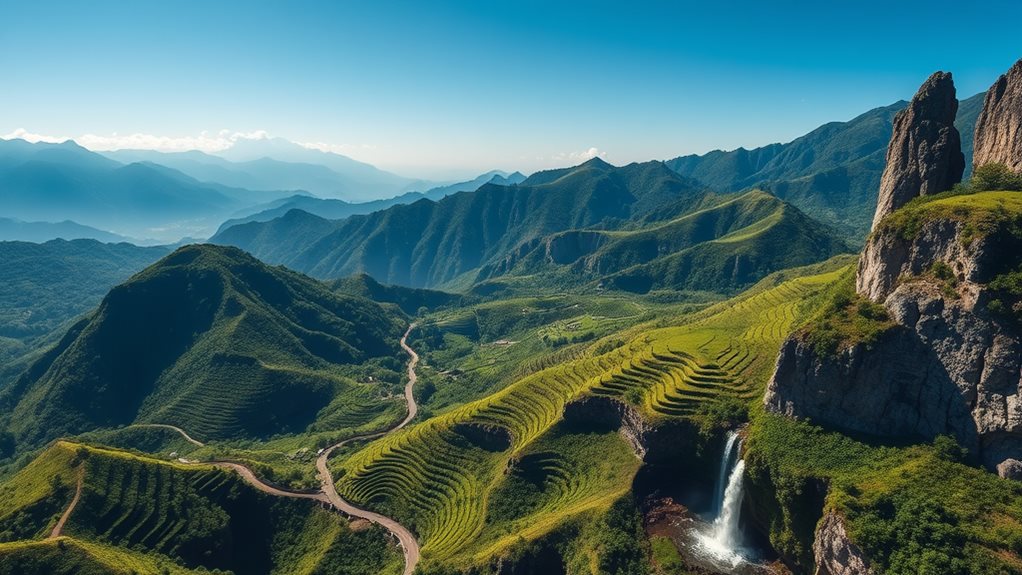
When it comes to exploring the stunning natural beauty of the Cordillera region, there are numerous tour options to suit every interest and budget. You'll find a range of choices that cater to history buffs, outdoor enthusiasts, and those seeking cultural immersion.
The Philippine Cordilleras boasts several UNESCO World Heritage Sites, including the Banaue Rice Terraces, making it an ideal destination for cultural and natural explorers.
You can choose from a variety of tour options, such as the Banaue & Batad UNESCO 3 Days 2 Nights Tour, which offers an immersive experience in the mountains and valleys of Ifugao. This tour costs $360 per adult and has a 100% recommendation rate, making it an ideal choice for first-time visitors.
If you prefer a more active adventure, the Small-Group Weekend Hiking Tour to Banaue-Ifugao is a great option, lasting over 3 days and costing $270 per adult with a 95% recommendation rate.
For a more extensive journey, the 5 Days Sagada Banaue Batad Discovery tour is a must-choose, costing $1,062 per adult and boasting a 92% recommendation rate. This tour is perfect for those who want to explore deeper into history and nature.
Alternatively, the Batad Guided Tour offers a 6-hour cultural experience with a local guide for $70 per group, allowing you to explore the terraces in detail.
You also have the option to choose the Shared 4 Days 3 Nights Banaue and Sagada Tour Package, priced at $544 per adult, providing a balanced itinerary of cultural and natural highlights.
Guided Tours and Cultural Experiences
The region's rich history and culture come alive with guided tours, offering cultural immersion experiences that explore the heart of the Philippines' Cordillera. You'll be able to investigate the traditions of the Ifugao people as you explore the breathtaking rice terraces, which have been cultivated for centuries. Your local guide will provide you with a deeper understanding of the significance of these ancient agricultural techniques, sharing stories about the Ifugao rice farming practices and the community's customs.
As you commence on a guided tour, you'll be immersed in the daily life of the Ifugao people, from watching artisanal craftsmanship to participating in traditional dance performances. You'll have the chance to engage with local artisans, trying your hand at traditional weaving or pottery, and maybe even assisting with the preparation of a traditional meal.
Many tours include the opportunity to partake in local festivals, where you can mingle with the community and experience their vibrant culture firsthand. For an even more personalized experience, you can opt for a customized tour that caters to your interests, whether you're interested in hiking, cultural exploration, or simply taking in the stunning scenery.
Guided tours also offer the chance to indulge in Ifugao cuisine, featuring local delicacies like sag-ping and binangol, which showcase the region's rich agricultural practices and unique flavors.
With safety and authenticity guaranteed, your guided tour will be a once-in-a-lifetime experience, enriching your understanding of the Philippines' rich history and heritage.
How Do the Banaue Rice Terraces Represent the Wonders of the Philippine Cordilleras?
The banaue rice terraces are a testament to the ancestral ingenuity and harmony with nature of the Ifugao people. Carved into the rugged Cordilleras over 2,000 years ago, these terraces embody sustainable farming and breathtaking artistry, showcasing the Philippines’ profound cultural heritage and the timeless wonders of its mountainous landscapes.
Sustainable Tourism in the Region
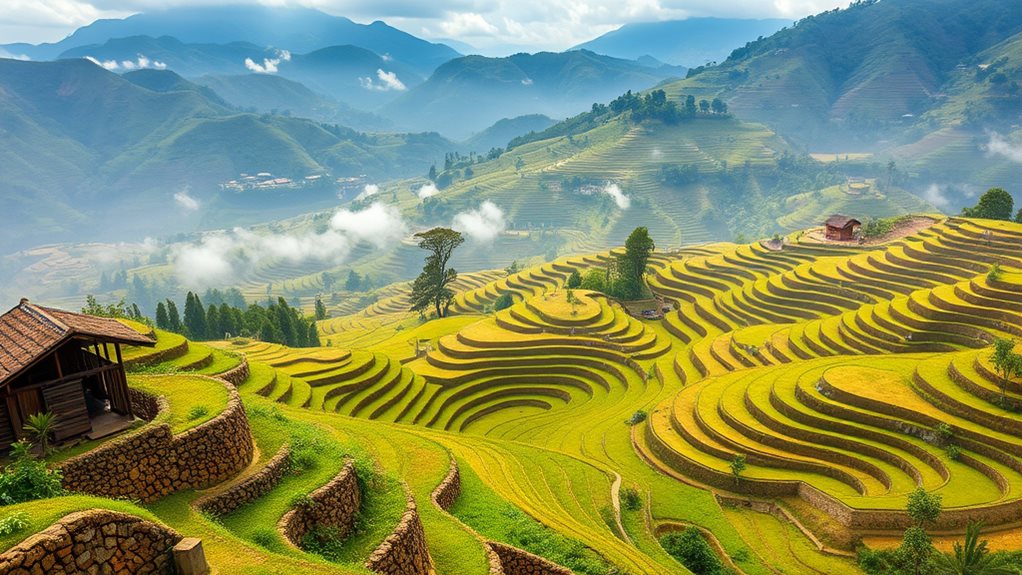
Sustainable tourism in the Philippine Cordilleras is built on a delicate balance between economic development and cultural preservation. As you venture into the region, you'll discover initiatives that allow visitors like you to experience the traditional way of life of the Ifugao people.
Community-based tourism is at the forefront of this effort, enabling you to engage with local communities and learn about their farming methods, cultural practices, and daily lives. By immersing yourself in these experiences, you foster mutual respect and understanding, creating a win-win situation for both visitors and host communities.
As you explore the region, you'll notice eco-friendly accommodations and tours that prioritize minimizing environmental impact. You might stay in a locally-run homestay or join a guided hike to learn about the region's unique ecosystem.
Cultural immersion experiences are also available, allowing you to investigate deeper into the Ifugao culture and its connection to the rice terraces. These strategies not only support sustainable tourism but also promote education on the importance of conserving the rice terraces and surrounding ecosystems.
In addition, sustainable tourism plays an essential role in reviving interest in traditional agriculture among younger generations, striking a balance between economic development and cultural preservation.
As you travel through the Philippine Cordilleras, you'll be contributing to the preservation of this unique cultural heritage while gaining unforgettable experiences.
Long-term Conservation and Management
As you've gained a deeper appreciation for the cultural heritage and natural beauty of the Philippine Cordilleras through your immersive experiences in sustainable tourism, you may wonder how this fragile ecosystem will be preserved for future generations.
Your fascination with the region's intricate rice terraces and unique cultural traditions brings to mind the pressing need for effective long-term conservation and management efforts.
Implementing Community-Based Land Use and Zoning Plans (CBLUZP) is an important step in this process, allowing traditional boundaries to define sustainable management practices and protect the delicate balance of the ecosystem.
The Ifugao Terraces Commission plays an essential role in overseeing the protection of the terraces through national laws and ancestral land use traditions, addressing the vulnerabilities posed by social and economic changes.
Successful government programs in recent years have focused on improving economic conditions while preserving the terraces, incorporating local communities in decision-making processes to guarantee sustainable conservation.
The designation as a World Heritage in Danger in 2001 highlighted the challenges faced by the terraces, but corrective measures have since been put in place to mitigate threats such as rural-to-urban migration and climate change.
Effective management and conservation efforts are critical to preserving the authenticity and cultural significance of the terraces and safeguarding traditional agricultural practices for future generations.